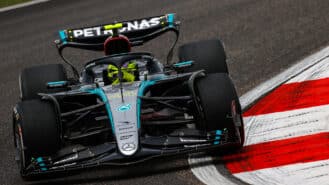
Hamilton moans earn him F1 highlights reel – Up/Down in China
The king of positive vibes has seen his crown slipping recently – a grey day in China only deepened the Silver Arrows' Slough of Despond
Probably the single most interesting exhibit at the Beijing Auto Show last week was an engine and a gearbox in a glass case on the Ferrari stand.
Visually at least Ferrari engines are no longer the works of art they once were because of all the ancillary systems and sensors that must be attached to them, but this one drew your eye to it for a different reason: it had an electric motor attached to it.
Were this an engine from its Formula 1 car, this would be no news as all F1 engines have been so equipped since the introduction of KERS. But this was a road car engine – a 6.3-litre V12 no less – similar to that used in the FF coupe and forthcoming F12 supercar, but with an as yet unspecified amount of electrical assistance. It is, in effect, Ferrari’s first hybrid.
It is also one of relatively rare occasions where lessons learned on the track really have translated to the road. Others include the carbon fibre monocoque, carbon ceramic brakes and paddle shift transmissions. Ferrari claims this system follows the exact principle of its F1 KERS equipment, even if none of the componentry is common. It harvests and stores energy that would otherwise be lost under braking, so it can be deployed to provide a short burst of additional and effectively free power when the driver demands.
So far so good. But probe Ferrari further on the subject and ask questions like how much power can it provide and for how long, or how much additional weight is added by the system and suddenly nothing is coming the other way. The only tantalising sliver of data it will offer is that it is close to its target of providing a kilowatt of additional power (1.341bhp) for every addition kilogramme of weight it adds. This is very encouraging as it requires only an extra 75kg to add slightly more than 100bhp to the engine’s power output. Given that in the F12 the engine gives 720bhp without any assistance, the potential output of a specially tuned version with KERS is probably enough to give Bugatti nightmares.
There is another advantage here. Whatever its output, Ferrari says its CO2 emissions are no less than 40 per cent lower than they’d have been had they tried to achieve the same output without KERS. And that is a staggering achievement.
So now for the bad news. This KERS system is rather dear. So expensive indeed that at present Ferrari can only consider using it on the next in a line of limited edition, ultra-expensive supercars that started with the 288GTO, progressed through Fs 40 and 50 to the Enzo. The Enzo successor is in an advanced state of development and will be shown next year, complete with a carbon fibre tub and body. Even with KERS its engine is unlikely to match the 987bhp of the Bugatti Veyron, but nor will it need to for the car is tipped some hundreds of kilos less than the two-tonne Bug, raising once more the spectre of Ferrari producing the world’s fastest road car, a title it has not held since the F40 made its debut almost a quarter of a century ago.
Ferrari says the cost of the KERS will reduce in time and anticipates being in a position to offer it on other cars in its ranges by the middle of the decade.

The king of positive vibes has seen his crown slipping recently – a grey day in China only deepened the Silver Arrows' Slough of Despond

In the face of soul-destroying boredom, only one driver can bring the entertainment needed to rescue a sport which resembles a broken AI tribute to itself

Waking up at 4am on a Sunday is rarely worth it, especially when Max Verstappen looks poised to take another lights out to chequered flag victory — as he did…

Should there be a new prize for a team finishing sixth in the championship – just like the Jim Clark Trophy in the good old turbo times?